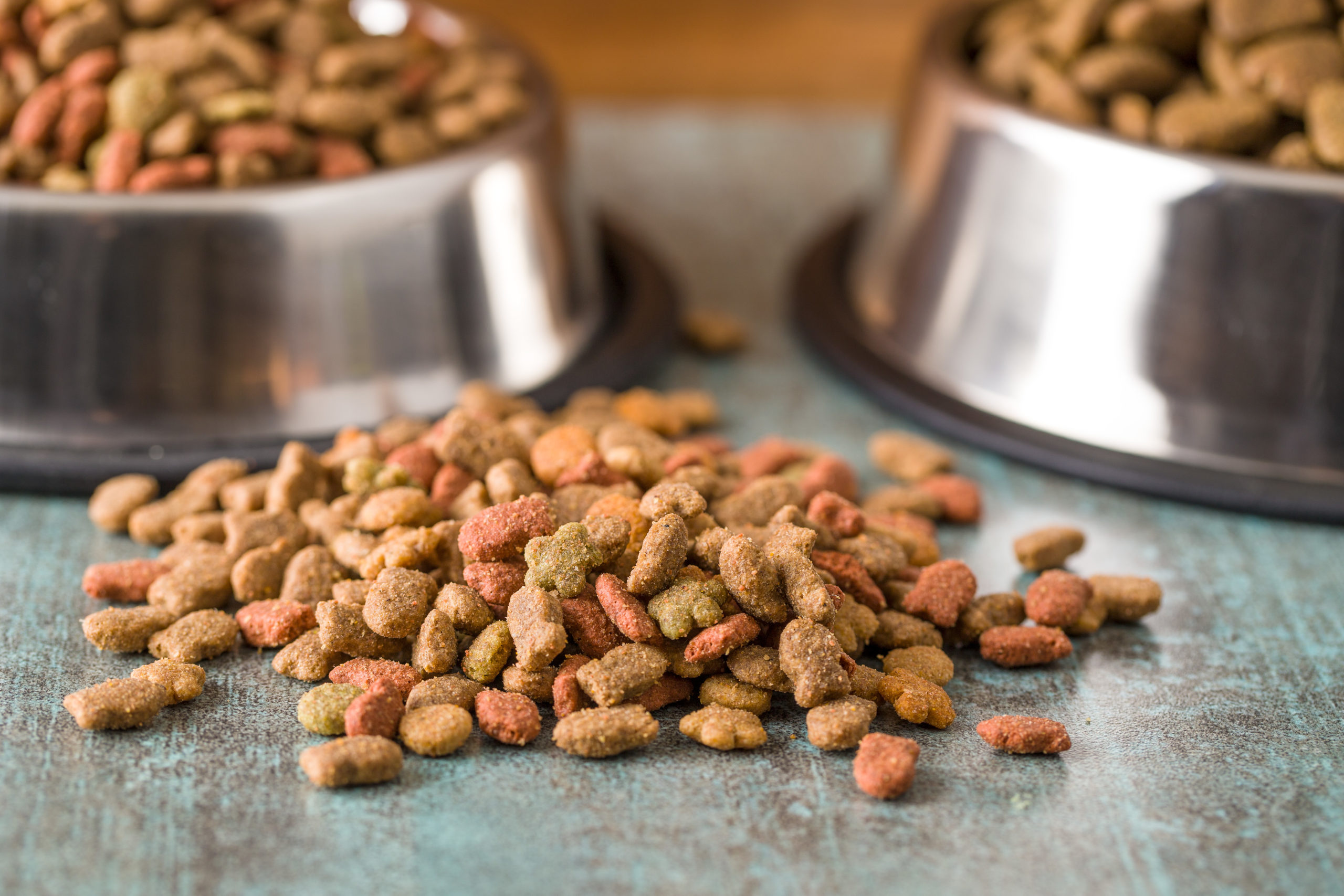Starting your puppy’s life off right begins with their overall diet and nutrition, just like human babies. One of the most important aspects of taking care of your Bernedoodle puppy is feeding them. Knowing when and how much to feed your new puppy gives them the proper nutrients while also teaching them a routine.
Choose dog food based on your Bernedoodle’s size and nutritional needs. The activity level of your Bernedoodle puppy will also determine the amount of food you give him. Your puppy’s age determines the timing of the feeding schedule.
Feeding your Bernedoodle puppy doesn’t have to be a difficult process, you just need the right tools! Here we’ve put together the Bernedoodle puppy feeding guide for you to have the tools to choose the right dog food, know when and how much to feed your puppy, and more.
Contents
The Basics of the Bernedoodle
The Bernedoodle is a combination of the Bernese Mountain Dog and the Poodle. They are smart dogs, family-friendly, and very loyal. They can vary in size from 10 pounds to 50 pounds because poodles come in different sizes (toy, miniature and standard). Their personalities can vary quite a bit as well, making each Bernedoodle unique! It really depends on which parent breed they take after.
They can differ even more the original litter is bred with other Poodles or Bernese Mountain Dogs. Additionally, the Bernedoodle is a newer breed so people are still learning about them with each generation.
The Bernedoodle’s coat comes in a variety of combinations of black, white, and brown. They usually have curly or at least wavy coats that tend to shed less and cause fewer problems for allergy sufferers.
Bernedoodle’s are very loyal to their humans and need a lot of interaction. They do not like to be left alone and can develop separation anxiety. Good training can help to prevent this, however, and this quality makes them wonderful canine friends anyway.
Feeding Your Bernedoodle Puppy
Thorough knowledge of puppy feeding can help deter bad behavior and potential health issues down the road as your puppy blossoms into an adult.
How Should I Choose Dog Food for My Bernedoodle Puppy?
It is very important to choose a dog food that meets your puppy’s nutritional needs. Your puppy needs a well-balanced diet just like a human baby. It should contain a combination of proteins from both plant and meat sources, as well as some grains.
Also, puppy food and adult dog food are not the same. Puppies require more nutrients and more calories than adult dogs because they are growing so quickly.
You can choose between dry food, canned food, cooked food, or raw food. Most veterinarians say that dry food is best for your puppy’s teeth, whereas canned food and dry food both are best for overall nutrition.
Dry and canned foods are designed to provide all of the nutrients that your puppy needs to grow and be healthy. There are also size-specific food types you can choose from that contain different nutrient amounts or smaller kibble.
As puppies transition from nursing to puppy food, it may be easier to feed them a mixture of wet and dry food. This will help them adjust to eating just kibble as they get older.
While you can absolutely provide cooked or raw food for your dog, you will need to work diligently to ensure all of your puppy’s nutritional needs are being met.
How Often Should I Feed My Bernedoodle Puppy?
Bernedoodle puppies tend to overeat, so they must be kept on a feeding schedule. Puppies younger than four months can be allowed to graze as needed as they transition from nursing to puppy food. If you don’t want to leave food out all day, you can instead feed them four times per day.
At four months old, Bernedoodle puppies should be fed three times per day, at the same times each day. At six months old, you should transition your Bernedoodle puppy to feedings twice per day instead of three times.
Be sure to feed your Bernedoodle puppy early enough in the evening that he has time to digest and go potty or he may have accidents overnight.
How Much Should I Feed My Bernedoodle Puppy?
The amount of food you feed your Bernedoodle puppy can vary greatly based on the size of poodle the Bernese was bred with (toy, mini, or standard). Additionally, Bernedoodle’s are exuberant eaters that can easily overeat and become overweight.
Smaller Bernedoodle puppies, those that were bred from toy or miniature poodles, will require much less food than the larger Bernedoodle puppies. Keep an eye on the shape of your puppy. You should be able to see his ribs slightly and his tummy should tuck upward. You should not be able to see his hips, however.
Begin feeding your Bernedoodle puppy the smallest amount for their weight, but if he looks underweight, increase that amount gradually. If he looks overweight, decrease his food intake.
The first step to determine how much to feed your puppy is to figure out approximately what your puppy will weigh once he is an adult. The following chart show approximately how much to feed your puppy based on weight and age range:
Bernedoodle Puppy Feeding Chart
| Adult Weight (lbs) | 6 weeks to 3 months | 4 – 5 months | 6 – 8 months | 9 – 11 months | 1 – 2 years |
| 10 – 12 | ½ to 1 cup | 2/3 to 1 1/3 cups | ½ to 1 1/2 cups | Feed as if Adult | Feed as if Adult |
| 13 – 20 | ½ to 1 ¼ cups | 1 1/8 to 2 cups | ¾ to 1 1/3 cups | 1 to ½ cups | Feed as if Adult |
| 21 – 50 | ½ to 1 ½ cups | 1 ½ to 2 ¾ cups | 1 1/8 to 2 1/3 cups | 2 to 3 cups | 2 to 4 ¼ cups |
| 51 – 75 | 5/8 to 2 1/3 cups | 1 ½ to 4 cups | 1 ½ to 3 ¾ cups | 2 ½ to 4 ¾ cups | 2 5/8 to 6 ¼ cups |
| 76 – 90 | 1 to 2 2/3 cups | 2 7/8 to 3 ¾ cups | 2 7/8 to 6 1/3 cups | 3 7/8 to 7 cups | 5 5/8 to 11 cups |
Remember that every puppy is different, and these amounts may need to be adjusted.
Bernedoodles are prone to becoming overweight for two reasons: they are voracious eaters and aren’t inclined to being very active. This is why it is very important to begin watching your puppy’s weight even while he is young. If you go on a walk or run, your Bernedoodle will happily join you, but he is also happy lying on the couch all day.
Thankfully, Bernedoodles don’t require a lot of exercise to meet their minimum daily needs, but you or another canine pal may need to encourage him to get up play.
What About Puppy Treats?
Treats can be used for training, but you do have to be careful because of the Bernedoodle’s naturally large appetite. You can use protein-dense treats for positive reinforcement of your puppy’s good behavior to help prevent weight gain. Specially designed puppy treats for training focus on protein and have low calories, as well as brain-supporting DHA.
Don’t feed your puppy human food. Dogs have toxicity to some foods that are fine for humans. Also, if your pup is begging for food and you give in, you’re teaching him a bad behavior that will be next to impossible to break.
5 Tips for Feeding your Bernedoodle Puppy
- Hand-feed your puppy at times to teach him that you are in charge of his food. Have guests hand feed him also!
- Feed your puppy at your mealtime when possible so he learns that he should be eating at his bowl when you are eating and not begging at the table.
- Use kibble as a reward for good behavior during times he must be handled.
- Use slow-feeding dog bowls to help these voracious eaters to slow down.
- Feed your puppy in the same area of your home for every meal. Set up his food and water bowl there so he knows that is where he is supposed to eat.
Related Questions
How much exercise does a Bernedoodle puppy need?
Because Bernedoodle’s can become overweight easily, it is important to keep them active, and starting them young is a good idea. The easiest way to determine how much exercise they need is to figure 5 minutes for each month in age.
When should I start by Bernedoodle puppy with socialization?
You should certainly begin socializing Bernedoodle puppies early as it can be difficult to predict a dog’s temperament, especially a hybrid breed.
Are Bernedoodle puppies easy to train?
Bernedoodle’s can be quite stubborn. For this reason, you need to begin training while your puppy is young. Begin with the basics and work up as they master each level. A well-trained pooch will be more inclined to be active as well when exercise is needed.

